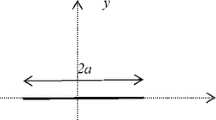Abstract
In the fracture theory of Bilby, Cottrell and Swinden, the plastic zone in an infinitely thick specimen was represented as a distribution of dislocations. For a specimen of finite thickness, Eshelby and Stroh have shown that the interaction force between two screw dislocations can be expressed by a modified Bessel function which decays much faster than the inverse first power law as the distance between the dislocations is increased. By assuming a continuous distribution of dislocations, an integral equation based on the Eshelby and Stroh interaction is formulated to examine the effect of thickness on the plastic zone size as well as the relative displacement along the crack surfaces. The distribution function of dislocations is obtained numerically from this integral equation. Numerical results indicate that for a given crack opening displacement the length of the plastic zone decreases with decreasing specimen thickness. Energy release rate is discussed from the dislocation point of view. A previous result that the energy release rate is equal to the total force on the dislocations in the plastic zone is generalized to the case of a plate with finite thickness.
Résumé
Dans la théorie de rupture de Bilby, Cottrell et Swinden, la zone plastique dans une éprouvette infiniment épaisse a été représentée par une distribution de dislocations. Dans le cas d'une éprouvette d'épaisseur finie, Eshelby et Stroh ont montré que la force d'interaction entre deux dislocations-vis peut être exprimée par une fonction modifiée de Bessel qui décroît beaucoup plus rapidement que la loi de puissance inverse lorsque la distance entre les dislocations s'accroit. En supposant une distribution continue de dislocations, on a formulé une équation intégrale basée sur l'interaction d'Eshelby et Stroh en vue d'examiner l'effet de l'épaisseur sur la dimension de la zone plastique, ainsi que le déplacement relatif le long des surfaces de la fissure. La fonction de distribution des dislocations est obtenue par voie numérique à partir de l'équation intégrale. Des résultats numériques indiquent que pour un déplacement d'ouverture de fissure donnée, la longueur de la zone plastique décroît lorsque décroît l'épaisseur de l'éprouvette. On discute le taux de relaxation de l'énergie du point de vue des dislocations. Un résultat précédent montrant que le taux de relaxation d'énergie était égal à la force totale des dislocations dans la zone plastique est à présent généralisé au cas d'une plaque d'épaisseur finie.
Similar content being viewed by others
References
B.A. Bilby, A.H. Cottrell and K.H. Swinden,Proceedings of Royal Society A272 (1963) 304.
V. Vitek,Journal of the Mechanics and Physics of Solids 24 (1976) 67.
V. Vitek,Journal of the Mechanics and Physics of Solids 24 (1976) 263.
H. Riedel,Journal of the Mechanics and Physics of Solids 24 (1976) 277.
J.D. Eshelby and A.N. Stroh,Philosophical Magazine 42 (1951) 1401.
S.M. Ohr and J. Narayan,Philosophical Magazine A41 (1980) 81.
S. Kobayashi and S.M. Ohr,Philosophical Magazine A42 (1980) 763.
S.-J. Chang and S.M. Ohr,Dislocation Modelling of Physical Systems, eds M.F. Ashby et al., Pergamon Press (1980) 28.
S.-J. Chang and S.M. Ohr,Journal of Applied Physics (1981) to appear.
S.-J. Chang,International Journal of Fracture 16 (1980) R79–R82.
F. Erdogan and G. D. Gupta,Quartely of Applied Mathematics 29 (1972) 525.
J.E. Sinclair,Proceedings of the 1976 International Confèrence on Computer Simulation for Materials Applications, Nuclear Metallurgy, V. 20, Part 1, (1976) 388–404.
R.W. Lardner,International Journal of Fracture 4 (1968) 299–319.
B.A. Bilby and K.H. Swinden,Proceedings of Royal Society A285 (1965) 22.
L.M. Delves and J. Walsh,Numerical Solution of Integral Equations, Clarendon Press, Oxford (1974).
G.G. Chell and P.T. Head,International Journal of Fracture 11 (1975) 11349–11351 and 12 (1976)11172–11174.
J.R. Rice,International Journal of Fracture 11 (1975) 11352–11353.
Author information
Authors and Affiliations
Additional information
Research sponsored by the Applied Mathematical Sciences Research Program, Office of Energy Research, and the Division of Materials Sciences, U.S. Department of Energy under contract W-7405-eng-26 with the Union Carbide Corporation.
Rights and permissions
About this article
Cite this article
Chang, S.J., Ohr, S.M. Effect of thickness on plastic zone size in BCS theory of fracture. Int J Fract 21, 3–13 (1983). https://doi.org/10.1007/BF01134195
Received:
Revised:
Issue Date:
DOI: https://doi.org/10.1007/BF01134195



